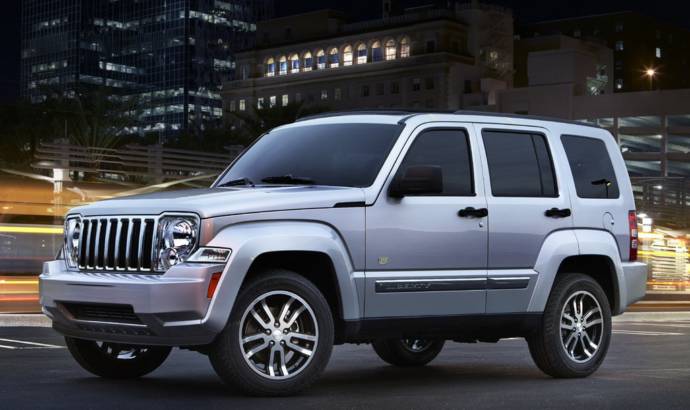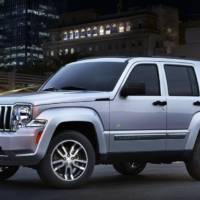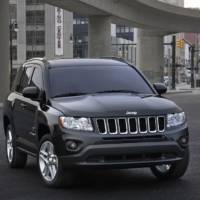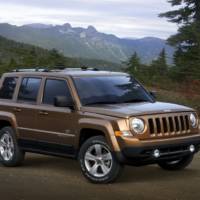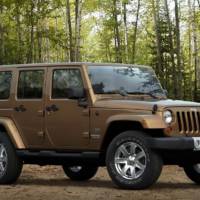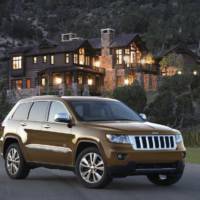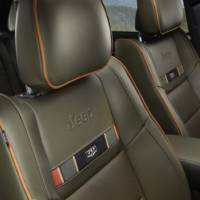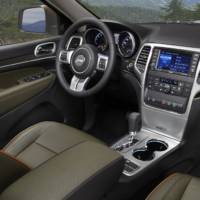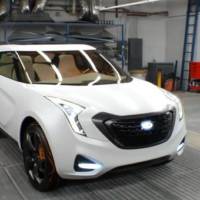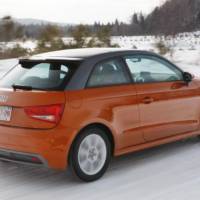Chrysler announced at this year’s edition Detroit Motor Show that it will launch five special edition Jeep models as part of celebrating the company’s 70th anniversary.
The Jeep 70th Anniversary Special Edition Models will include the 2011 Jeep Grand Cherokee, Compass, Patriot, Liberty and Wrangler, all of which will features unique body colours (Bronze Star), special wheels, perforated leather seats available in various colours, plus various other trim options and inserts.
For specific details as well as pricing for each of the five Jeep 70th Anniversary Special Edition Models check out the official press release below.
Jeep press release :
Jeep History
In July 1940, the U.S. military informed automakers that it was looking for a "light reconnaissance vehicle" to replace the Army’s motorcycle and modified Ford Model-T vehicles. The Army invited 135 manufacturers to bid on production and developed a lengthy specification list for the vehicle, including the following:
600-lb. load capacity
wheelbase less than 75 inches
height less than 36 inches
smooth-running engine from 3 to 50 miles per hour
rectangular-shaped body
four-wheel drive with two-speed transfer case
fold-down windshield
three bucket seats
blackout and driving lights
gross vehicle weight below 1,300 lbs.
At first, Willys-Overland and American Bantam Car Manufacturing Company were the only two companies answering the call. Soon, however, Ford Motor Company entered the picture, and competition began among the three over which company would receive the lucrative government contract.
Each company produced prototypes for testing in record time. Bantam’s chief engineer, along with a team of Bantam executives, worked out a design, and the company built its field car within 49 days.
Willys-Overland Vice President of Engineering Delmar G. Roos designed the Willys Quad. Ford developed its Model GP (General Purpose), known as the Pygmy, which was powered by an adapted Ford/Ferguson tractor. Each company delivered its prototype to the Army in the summer of 1940 and received approval to build 70 sample vehicles.
The Army took possession of these vehicles in November 1940 at Camp Holabird, Md. Each of the three designs exceeded the Army’s specification of 1,300 lbs., but the Army soon realized that limit was far too low and raised it for the next round of vehicles.
The Army issued the next round of contracts in March of 1941. Bantam was to produce 1,500 Model 40 BRC vehicles, Ford would build 1,500 modified and improved GP Pygmies, and Willys would build 1,500 Quads. Further testing and evaluation led to the Army’s selection of Willys vehicle as the primary manufacturer.
Subsequently, most of the Bantams and Ford GPs produced were sent to Great Britain and Russia as part of the lend-lease program. In Great Britain, the Ford vehicle was popularly known as the "Blitz Buggy."
Willys MA/MB
With modifications and improvements, the Willys Quad became the MA, and later the MB. But the Army, and the world, came to know it as the Jeep®.
Some claimed that the name came from the slurring of the letters "GP," the military abbreviation for "General Purpose." Others say the vehicle was named for a popular character named "Eugene the Jeep" in the Popeye cartoon strip. Whatever its origin, the name entered into the American lexicon and, for a while, served almost as a generic title for off-road vehicles, while the Jeep itself became an icon of the war.
The Willys MA featured a gearshift on the steering column, low side body cutouts, two circular instrument clusters on the dashboard, and a hand brake on the left side. Willys struggled to reduce the weight to the new Army specification of 2,160 lbs. Items removed in order for the MA to reach that goal were reinstalled on the next-generation MB resulting in a final weight of approximately just 400 lbs. above the specifications.
Willys-Overland would build more than 368,000 vehicles, and Ford, under license, some 277,000, for the U.S. Army. The rugged, reliable olive-drab vehicle would forever be known for helping win a world war.
Willys trademarked the "Jeep" name after the war and planned to turn the vehicle into an off-road utility vehicle for the farm – the civilian Universal Jeep. One of Willys’ slogans at the time was "The Sun Never Sets on the Mighty Jeep," and the company set about making sure the world recognized Willys as the creator of the vehicle.
OVERVIEW OF KEY HISTORICAL JEEP CIVILIAN VEHICLES
Jeep CJ-2A: 1945-49
The first civilian Jeep vehicle, the CJ-2A, was produced in 1945. It came with a tailgate, side-mounted spare tire, larger headlights, an external fuel cap and many more items that its military predecessors did not include. Several CJ-2A features – such as a 134 cubic inch I-4 engine, a T-90A transmission, Spicer 18 transfer case and a full-floating Dana 25 front and Dana 23-2 rear axle – were found on numerous Jeep vehicles in future years. The CJ-2A was produced for four years.
Jeep Jeepster: 1948-51
The Jeepster was the last phaeton-style open-bodied vehicle made by a U.S. automaker, using side curtains for weather protection instead of roll-down windows. Originally offered with the "Go-Devil" engine, it was eventually fitted with the 161 cubic-inch six-cylinder "Hurricane" engine, but never offered in four-wheel drive.
Jeep CJ-3A: 1949-53
Introduced in 1948, the CJ-3A was very similar to the previous model, but featured a one-piece windscreen and a more robust rear axle, and retained the original L-head four-cylinder engine.
Jeep CJ-3B: 1953-68
The CJ Model was updated in 1953, becoming the CJ-3B. It had a taller front grille and hood than its military predecessor in order to accommodate the new Hurricane F-Head four-cylinder engine. The CJ-3B remained in production until 1968 and a total of 155,494 were manufactured in the U.S. In 1953, Willys-Overland was sold to Henry J. Kaiser for $60 million. The Kaiser Company began an extensive research and development program that would broaden the Jeep product range.
Jeep CJ-5: 1955-83
In 1955, Kaiser introduced the CJ-5, based on the 1951 Korean War M-38A1, with its rounded front-fender design. It was slightly larger than the CJ-3B, as it featured an increased wheelbase and overall length. Improvements in engines, axles, transmissions and seating comfort made the CJ-5 an ideal vehicle for the public’s growing interest in off-road vehicles. The CJ-5 featured softer styling lines, including rounded body contours. With an 81-inch wheelbase, more than 600,000 CJ-5s were produced over 30 years.
Jeep CJ-6: 1956-75
A long-wheelbase (20 inches longer than the CJ-5) model was introduced and was known as CJ-6. Apart from a longer wheelbase, the CJ-6 was almost identical to the CJ-5, but with more cargo space. Jeep also introduced a forward-control cab-over-engine variation to the CJ line in 1956. AMC equipped both the CJ-5 and CJ-6 with heavier axles, bigger brakes and a wider track. In 1965, a new "Dauntless" V-6 engine was introduced as an option on both the 81-inch wheelbase CJ-5 and 101-inch wheelbase CJ-6. The 155-horsepower engine almost doubled the horsepower of the standard four-cylinder engine. It was the first time a Jeep CJ could be equipped with a V-6. Beginning in 1973, all Jeep CJs came equipped with AMC-built 304- or 360-cubic-inch V-8 engines.
Jeep Pickup: 1947-65
A 118-inch wheelbase pickup that realized few product changes. It was Willys-Overland’s first attempt to diversify the Jeep brand from the CJ.
(Jeep) Willys Wagon: 1946-65
A 104.5-inch wheelbase wagon long an enthusiast favorite. Four-wheel drive was introduced in 1949.
Jeep Wagoneer/Grand Wagoneer/Cherokee (SJ): 1963-91
In 1962, Jeep introduced the first automatic transmission in a four-wheel-drive vehicle, in the Wagoneer line (a predecessor to the Jeep Cherokee). The 1963 Jeep Wagoneer was also the first four-wheel-drive vehicle with an independent front suspension option. Quadra-Trac®, the first automatic full-time four-wheel-drive system, was introduced in 1973, available in full-size Jeep trucks and wagons, and later in the CJ-7.
Jeep FC 150/170 Pickup: 1957-65
These Forward-Control series Jeep vehicles were essentially work trucks – with an 81-inch wheelbase for the FC 150 and 103.5 inches for the FC 170. They received few changes during their lifecycle, though some 1959 and 1960 models featured full-floating front and rear axles, and some 1959 models included dual rear wheels and a four-speed manual transmission.
Jeep Gladiator/J-Series Pickup: 1963-87
Resembling the Wagoneer, Gladiator debuted in 1963 in either 120-inch (J-200) or 126-inch (J-300) form, and featuring a Dana 20 transfer case and Dana 44s front and rear. The Gladiator name was dropped in 1972.
Jeep Commando: 1967-73
A 101-inch wheelbase vehicle equipped with the "Dauntless" V-6 and full-floating Dana 27 and 44 rear axles. Fewer than 100 versions of the 1971 Commando Hurst Special were produced, making it one of the favorite and rarest vehicles among Jeep collectors.
Jeep CJ-7: 1976-86
In 1976, AMC introduced the CJ-7, the first major change in Jeep design in 20 years. The CJ-7 had a slightly longer wheelbase than the CJ-5 in order to allow space for an automatic transmission. For the first time, the CJ-7 offered an optional molded plastic top and steel doors. Both the 93.5-inch wheelbase CJ-7 and 83.5-inch wheelbase CJ-5 models were built until 1983 when demand for the CJ-7 left AMC no choice but to discontinue the CJ-5, after a 30-year production run.
Jeep CJ-8 Scrambler: 1981-85
Introduced in 1981, the Scrambler was a Jeep similar to the CJ-7, but with a longer wheelbase. Known internationally as the CJ-8, it was available in either hard- or soft-top versions. Less than 30,000 Scramblers were built, though they are extremely popular among collectors today.
Jeep Cherokee (XJ): 1984-01
Built on a unibody platform, the Cherokee XJ was a smaller but much more advanced version of the Cherokee SJ. Highlights included the introduction of Jeep’s Command-Trac® four-wheel-drive system and Quadra-Link coil front suspension. Cherokee Limited debuted in 1988, and a 4.0-liter I-6 was introduced in 1989.
Jeep Wrangler (YJ): 1987-96
In 1983, the growing market for compact four-wheel-drive vehicles still sought the utilitarian virtues of the Jeep CJ series, but consumers also were seeking more of the "creature comforts" found in passenger cars. The response was discontinuing the CJ series and introducing the 1987 Jeep Wrangler (YJ).
Although the Wrangler shared the familiar open-body profile of the CJ-7, it contained few common parts with its famous predecessor. Mechanically, the Wrangler had more in common with the Cherokee than the CJ-7. The Wrangler YJ had square headlights, which was a first (and last) for this type of Jeep. The YJ model exceeded 630,000 units.
On Aug. 5, 1987, about a year after the introduction of the Wrangler, American Motors Corporation was sold to the Chrysler Corporation and the popular Jeep brand became a part of Chrysler’s Jeep/Eagle Division.
Jeep Comanche (MJ): 1986-92
Based on the Cherokee platform and similarly equipped, the pickup received a six-foot bed in 1987. Later models offered Selec-Trac® or Command-Trac four-wheel drive.
Jeep Grand Cherokee (ZJ/WJ): 1993-2004
The Grand Cherokee famously first appeared by crashing through the convention center glass at the North American International Auto Show in Detroit during its introduction there on Jan. 7, 1992. The first SUV equipped with a driver’s side air bag, it set new standards for on-road ride, handling and comfort in an SUV.
Jeep Wrangler (TJ): 1997-2006
The 1997 Jeep Wrangler (TJ) looked very similar to the CJ-7. Indeed its ‘retro’ look was quite deliberate, but very different from a mechanical standpoint. Nearly 80 percent of the vehicle parts were newly designed. The TJ used a four-link coil suspension, similar to the Jeep Grand Cherokee, and featured a new interior, including driver and passenger air bags. The TJ retained several classic Jeep features such as round headlights, a fold-down windshield (first seen in 1940) and removable doors, as well as a choice of a soft top or removable hard top. A factory-fitted sport bar was also standard.
Enter the then-best-equipped Jeep ever – the 2003 Jeep Wrangler Rubicon. This vehicle earned the right to be called by the legendary trail name, as it was equipped with push-button-actuated locking front and rear Dana 44 axles, a 4:1 low-range transfer case, 32-inch tires and many more options not available on any production Jeep before it.
In 2004, the Jeep Wrangler Unlimited was introduced – a longer-wheelbase Wrangler, featuring 13 inches more cargo room and 2 inches of additional second-row legroom. While maintaining the unmatched open-air fun and 4×4 capability of the original Jeep Wrangler, the Unlimited model offered more refined on-road comfort, as well as even more versatility.
Jeep Liberty: 2002-present
Liberty replaced the Cherokee as a mid-size SUV entry and is the first Jeep vehicle to feature standard independent front suspension. It also introduced the industry-exclusive Sky-Slider open-air roof in 2008.
Jeep Grand Cherokee (WK): 2005-10
A complete redesign of the ZJ/WJ, it boasted improved ride and handling capabilities, the 5.7-liter HEMI® V-8 and upscale amenities to make luxury car buyers envious.
Jeep Commander: 2006-10
A seven-passenger three-row Jeep based on the WK platform, but two inches longer, with unique stadium-style seating.
Jeep Compass and Patriot: 2007-present
The Jeep brand’s entries into the popular compact-SUV segment, these vehicles offer unsurpassed capability and 4×4 fuel economy in their class.
Jeep Wrangler and Wrangler Unlimited (JK): 2007-present
Building on the successful, original Jeep formula with an all-new frame, exterior and interior design, engine, and safety and convenience features, the JK delivers more capability, refinement, interior space and comfort, open-air fun, power, fuel efficiency and safety features.
Featuring a one-of-a-kind, four-door open-air design, the JK Wrangler expanded the Jeep experience to new dimensions. With room for five adult passengers – a Wrangler first – and the most cargo space ever offered in a Wrangler, the Unlimited combines class-leading off-road capability with everyday practicality
Today’s Wrangler models are lean, rugged and simple, achieving best-in-class off-road capability while delivering a true open-air driving experience. For 2011, all Wranglers boast an all-new interior, and Sahara models feature a more premium body-color hardtop.
Jeep Grand Cherokee (also WK): 2011-present
All-new for 2011 and more than 4 million sales after the first Grand Cherokee, Jeep improves the formula and delivers the perfect blend of on-road refinement and off-road capability. The new WK provides premium on-road performance, legendary Jeep craftsmanship, improved fuel economy, a world-class interior, a sleek new exterior design, true American craftsmanship and a host of safety and technology features.

